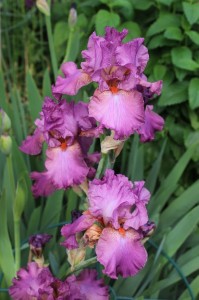 With over 300 species of irises available to grow in your gardens, you might need some kind of plant labels to help you tell one from the other. Markers for irises will help you differentiate species that have even the most subtle purple hue changes. Irises come in bright yellows, deep purples and many shades in between. While irises are very hardy plants, common in many gardens, they need to have some special care in order to keep their blooms active and keep the whole plant healthy.
With over 300 species of irises available to grow in your gardens, you might need some kind of plant labels to help you tell one from the other. Markers for irises will help you differentiate species that have even the most subtle purple hue changes. Irises come in bright yellows, deep purples and many shades in between. While irises are very hardy plants, common in many gardens, they need to have some special care in order to keep their blooms active and keep the whole plant healthy.
Perfect Planting Place
When planting your irises, put them in a spot where for at least half of the day they will have a good amount of full sunshine. Irises need plenty of sunshine in order for them to bloom. Otherwise, you might just have a nice clump of tall grassy-looking leaves. Markers for irises come in very handy when this might happen.
Over time your garden’s environment might change in subtle ways without you realizing it right away. As small trees begin maturing, they may start casting shadows and causing shade in places that used to be sunny spots. A sunny corner where you may have once planted irises may eventually turn into a shady corner when that oak tree climbs into your yard’s sky. This is the time to move your irises and your plant markers with them. It’s best to plant them just after their blooms have faded.
Don’t Pack Them In
The Farmer’s Almanac recommends that irises be thinned, generally, every two to five years to keep the flowers blooming and to keep the plant from becoming too crowded. When irises are left alone they become thickly overgrown. When they are packed too tightly together, sun and air can’t reach their rhizomes and they become vulnerable to moisture, rot and disease. You may have the instinct to completely keep iris rhizomes covered with dirt, but theses rhizomes need to be exposed to sunlight and ventilation.
When you divide your irises, it’s recommended that you check the rhizomes for borers that will destroy your plant. Besides a few pesky insects and too much moisture, not much else will destroy your hardy irises. Troublesome backyard deer won’t graze on them and irises won’t wither away in the hottest of summer days. We love them for their elegant petals with such intricate veins or their interesting fragrance or their comforting color, but we also love their strength and hardiness.
Irises need to be divided in order to keep up their beautiful blooms. When you divide them and spread them around to sunny places in your yard, you may want to order some more plant markers to add to the newly transplanted groupings. Plant markers for irises, like the ones manufactured by Kincaid Plant Markers, will help you keep track of where all those different species may move to around your yard.
